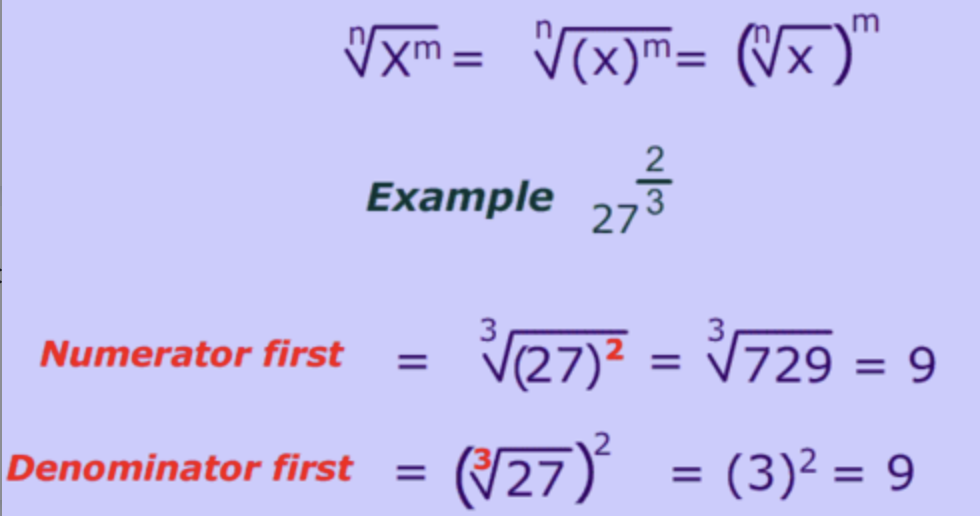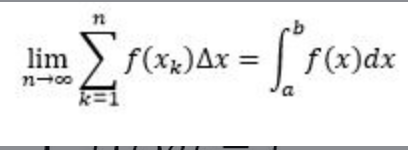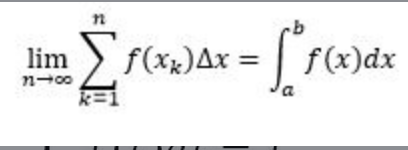Ultimate AB Calc Cheat Sheet
1/100
Earn XP
Description and Tags
Name | Mastery | Learn | Test | Matching | Spaced |
|---|
No study sessions yet.
101 Terms
if k is a positive constant, then the limit as x approaches 0 of (k/x^2) =
positive infinity
if the limit as x approaches a of f(x) = L1 and the limit as x approaches a of g(x) = L2, then the limit as x approaches a of [f(x) + g(x)] =
L1 + L2
if the limits for both f(x) and g(x) DNE but the sums of the right hand and left hand limits are the same, then. . .
the sum is the answer (same for multiplication and division)
the limits of x to the power fractions
remember what ms. pisapia said in class about how the limit as x approaches infinity makes the other numbers insignificant
when you are taking the limit and the denominator is 0, then. . .
the limit will be positive or negative infinity depending on the sign of the function
limit as x approaches 0: sinx/x
1
limit as x approaches 0: (1-cosx)/x
0
derivative of a function definition
f'(x) = limit as h approaches 0 of (f(x+h)-f(x))/h
continuity criteria
f(x) exists
limit as x approaches a of f(x) exists
f(x) = limit as x approaches a of f(x)
jump discontinuity
when the curve "breaks" at a particular place and limits from left and right exist, but they will not match
essential discontinuity
vertical asymptote
removable discontinuity
a "hole" in a graph
even function
graph is symmetrical with respect to the y-axis; f(x) = f(-x)
odd function
graph is symmetrical with respect to the origin; f(-x)=-f(x),
identical after rotating 180 degrees
if the highest power of x is in the numerator, then
the limit as x approaches infinity is infinity
if the highest power of x is in the denominator, then
the limit as x approaches infinity is zero
if the numerator and denominator have equal powers, then
the limit as x approaches infinity is the coefficients divided by each other
the derivative of a turn in a curve =
0
when does the derivative not exist
sharp corners
vertical tangent lines/asymptotes
cusps
discontinuities
d/dx k/x (k is a constant)
-k/(x^2)
d/dx k * sqrt(x)
k/(2sqrt(x))
d/dx sinx
cosx
d/dx cosx
-sinx
d/dx tanx
sec^2x
d/dx cotx
-csc^2x
d/dx secx
secxtanx
d/dx cscx
-cscxcotx
chain rule
f'(g(x))g'(x)
d/dx ln(g(x))
1/g(x) * g'(x)
d/dx e^(g(x))
e^g(x) * g'(x)
d/dx loga(x)
1/xlna
d/dx loga(g(x))
g'(x)/g(x)lna
d/dx a^x (a is a constant)
a^x * ln(a)
d/dx x^x
x^x * (lnx+1)
d/dx a^(g(x)) (a is a constant)
a^x * ln(a) * g'(x)
quotient rule
lowdhigh-highdlow/low^2
product rule
f'(x)g(x)+f(x)g'(x)
d/dx inverse f(x) at y or x = c (constant)
1/f'(inverse of f(c)) (c could be the x or y-coordinate)
d/dx inverse sin(u)
1/sqrt(1-u^2) du/dx
d/dx inverse cos(u)
-1/sqrt(1-u^2) du/dx
d/dx inverse tan(u)
1/(1+u^2) du/dx
d/dx inverse cot(u)
-1/(1+u^2) du/dx
d/dx inverse sec(u)
1/(|u| * sqrt(u^2 - 1)) du/dx
d/dx inverse csc(u)
-1/(|u| * sqrt(u^2-1)) du/dx
when velocity and acceleration have the same signs
particle is speeding up
when velocity and acceleration have opposite signs
particle is slowing down
when the velocity is zero and the acceleration is NOT zero
the particle has momentarily stopped and is CHANGING DIRECTION
volume of a sphere
4/3πr³
surface area of a sphere
4πr²
volume of a conical cone
(1/3)πr²h
slope of tangent line necessary formula
y - y1 = m(x - x1)
normal line
line perpendicular to the tangent line
concave up tangent line
underestimate
concave down tangent line
overestimate
L'Hospital's Rule: 0/0 and infinity/infinity cases
just take the derivative of both the top and bottom and plug in the c-value
MUST BE WRITTEN IN FRACTION FORM
REPEAT UNTIL NOT IN INDETERMINATE FORM (0/0 or infinity/infinity)
limit as x approaches c of f(x)/g(x) = f'(c)/g'(c)
mean value theorem
if f(x) is continuous and differentiable, there's some point in the interval where the slope of the tangent line equals the slope of the secant line that connects the endpoints of the interval
f '(c) = [f(b) - f(a)]/(b - a)
rolle's theorem
if y = f(x) is continuous on the interval [a, b] and is differentiable everywhere on the interval (a, b), and if f(a) = f(b), then there is at least one number c between a and b such that f'(c) = 0
if f'(a) = 0 and f''(a) > 0, then . . .
there is a relative minimum
if f'(a) = 0 and f''(a) < 0, then . . .
there is a relative maximum
how to find vertical asymptotes
set the denominator equal to zero and solve for x
how to find horizontal asymptote
degree of numerator smaller than degree of denominator - y=0
degree of numerator same as degree of denominator - y= leading coefficient of numerator/ leading coefficient of denominator
degree of numerator greater than degree of denominator - no horizontal asymptote
to calculate the absolute extrema. . .
plug in ALL the critical points AND end points and see which y-value is the greatest/least
concavity is when the first derivative is increasing or decreasing, therefore....
if f''(x) > 0, concave up, if f''(x) < 0, concave down
fraction exponent simplify easy formula
look at picture

left riemann sum formula (under the condition that all the rectangles have the same width)
((b-a)/n) [y0 + y1 + y2 + y3 + . . . y(n-1)]
right riemann sum formula (under the condition that all the rectangles have the same width)
((b-a)/n) [y1 + y2 + y3 + y4 + . . . y(n)]
midpoint riemann sum formula (under the condition that all the rectangles have the same width)
((b-a)/n) [y(1/2) + y(3/2) + y(5/2) + y(7/2) + . . . y((2n-1)/2)]
trapezoid rule formula
(1/2)((f(x1)+f(x2))(h) + (f(x2)+f(x3))(h) + . . . )
inscribed vs. circumscribed
all corners of the rectangle lie inside the curve vs. all corners of the rectangle lie outside the curve
riemann sum formula complicated
the image isn't 100% accurate

fundamental theorem of calculus 1
d/dx ∫ (any constant to x) f(x) dx = f(x) (the constant changing does NOT matter)
if the upper limit of the integral is a function like x^2, then we multiply the answer by the derivative of that term

integral of sin(ax) dx
-cos(ax)/a + C
integral of cos(ax) dx
sin(ax)/a + C
integral of sec(ax) * tan (ax) dx
sec(ax)/a + C
integral of sec^2 dc
tan(ax)/x + C
integral of csc(ax) * cot(ax)(dx)
-csc(ax)/a + C
integral of csc^2 (ax)(dx)
(-cot(ax))/a + C
fundamental theorem of calculus 2
∫ f(x) dx on interval a to b = F(b) - F(a)
used this for that graph question to find f(-6) and f(5) when given the 1st derivative graph
integral of tanx dx
-ln|cosx| + C
integral of cotx dx
ln|sinx| + C
integral of secx dx
ln|secx + tanx| + C
integral of cscx dx
-ln|cscx+cotx| + C
integral of a^x dx
1/ln(a) * a^x + C
integral of 1/sqrt(1-x^2) dx
arcsinx + C
integral of 1/(1+x^2) dx
arctanx + C
Integral of 1/x(sqrt((x^2)-1))
arcsecx + C
when can you use long division to solve for integrals?
when the degree of the numerator is greater than the degree of the denominator
what does the function y = 1/x look like?
look at image

newton's law of cooling
T = (To - Ts) * e^(-kt) + Ts
Ts = surrounding temperature
To = initial temperature
ln(1)
0
when the rate of growth is proportional OR exponential...
dy/dt = ky
separation of variables
integration
y = Ce^(kt)
average value of a function on an interval
(1/b-a) (a,b)∫ f(x)dx
how to find the area between 2 curves expressed as a function of x (integral, unit 8)
integral from a to b [f(x) - g(x)]dx
when to integrate with respect to x or y
x: vertical slices, perpendicular to x-axis, when functions are higher than one another ( y = something)
y: horizontal slices, perpendicular to y-axis, horizontally higher (x = something)
equilateral triangle area
(s^2√3)/4
given the hypotenuse of an isoceles right triangle, the area is
((hypotenuse)^2)/4
volume with disc method around the x-axis
pi * integral from a to b [f(x)]^2 dx
volume with disc method around the y-axis
pi * integral from a to b [f(y)]^2 dx
removable discontinuity formula
when you factor the numerator and denominator, the term that you can cancel out is the REMOVABLE DISCONTINUITY